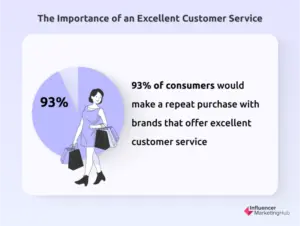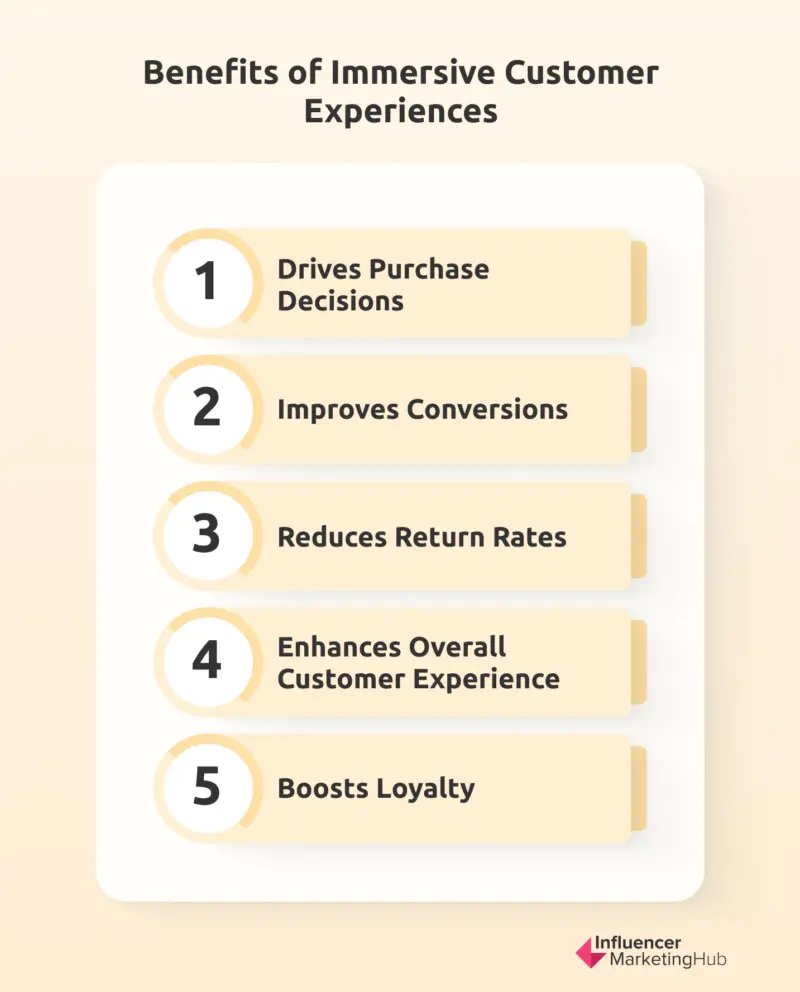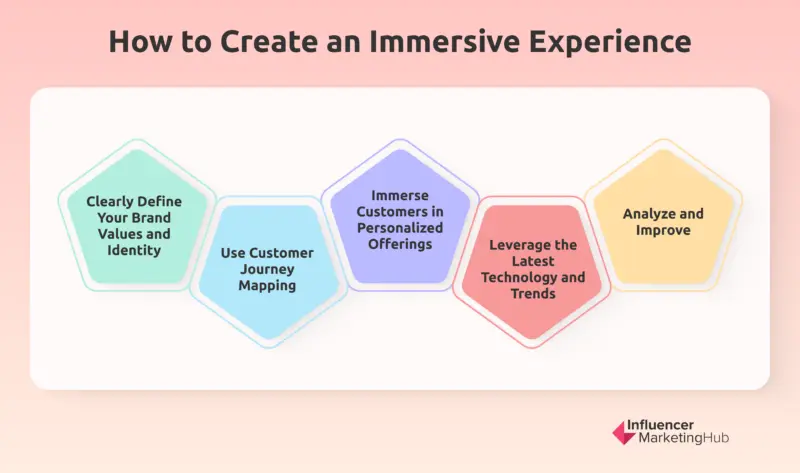When it comes to running a business, customer experience is everything. You may be offering great products at attractive prices, but if you can’t follow up with an exceptional experience, you’re going to lose customers. In fact, 65% of consumers have switched brands after a poor experience. Meanwhile, 93% of consumers would make a repeat purchase with brands that offer excellent customer service.
In other words, the experience you offer can make all the difference between losing and keeping your customers. But as more and more businesses start to realize this, it’s crucial to go one step further and differentiate yourself by providing an immersive experience to your customers. In this post, we help you navigate what an immersive customer experience means and how you can provide it.
What Is an Immersive Customer Experience?
An immersive customer experience can be described as the multisensory interactions that a consumer has with a brand or service across their customer journey. These interactions can take place through a number of modes including:
- Flat interfaces, which include screen-based experiences
- Natural interfaces, which includes experiences related to speech, sound, spatial, scent, touch, and gesture
- Extended reality, which includes virtual, augmented, and mixed reality experiences
Brands can use a combination of these modes to deliver multisensory experiences that consumers can emotionally connect with. As such, immersive customer experiences are an intuitive and compelling way for brands to differentiate themselves from the competition and have a lasting impact on their audience.
For example, even just being able to see the product in 3D and get a 360-degree view of it can help immerse consumers virtually. It enables them to experience the product and get a sense of how it might look and feel in real life, guiding them towards a purchase decision.

Source: emersya.com
Benefits of Immersive Customer Experiences
Delivering an immersive customer experience sounds like a lot of work, right? While that may be true, it absolutely makes up for all the benefits it provides. Here are some of the key reasons why you should consider providing an immersive customer experience.
Drives Purchase Decisions
Immersive experiences allow customers to get a better sense of how the product would look, feel, and work in real-life, thus making it easier to decide whether to go through with their purchase. This is particularly important for high-value products because customers may not want to risk buying something so expensive with just a 2D image of it.
On the other hand, by being able to see the details up close through a 360-degree product view, they may be convinced to buy it. This shows them how the product looks from all angles and allows them to zoom in on the finer details such as the material quality, the stitching, the hardware, and the finish.
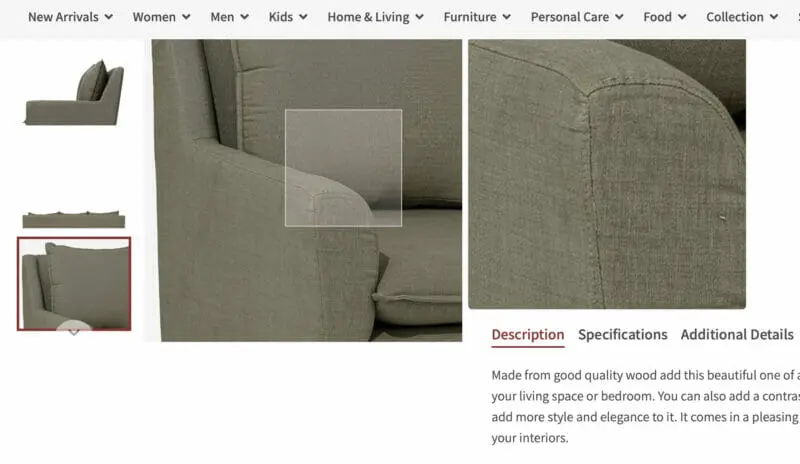
Source: fabindia.com
Moreover, some immersive experiences allow customers to get an idea of how the product would look on them or inside a particular space. As a result, they can make more informed decisions on whether or not to go through with the purchase.
Improves Conversions
Immersive experiences give customers the confidence to complete a purchase. By getting a better sense of how the product looks, works, and feels in real life, they can confidently make decisions about whether or not to buy it. As a result, an immersive experience could be the reason customers want to go through with their purchase.
In other words, you could drive more conversions because people feel more confident to go through with their purchases. Some case studies have even witnessed a 22% increase in conversion rate as a result of 360-degree product photos.
Reduces Return Rates
By the time customers make a purchase after an immersive experience, they already have a realistic expectation of how the product looks and feels in real life. Moreover, by being able to virtually place the product in their room or try it out themselves, they already know how it would fit and how it would look.
This significantly reduces the risk of returns because you’ve set realistic expectations. There’s a lower chance of customers returning their orders because “it wasn’t as expected” or “it didn’t fit in the room.”
Enhances Overall Customer Experience
Immersive experiences enable you to create a smoother buying journey for your customers. You give them the opportunity to interact and connect with your brand while setting realistic expectations about what to expect from the product. As a result, the overall customer experience is also enhanced.
Boosts Loyalty
An enhanced customer experience automatically translates to improved customer loyalty. Moreover, since customers have forged a strong emotional connection with your brand through those immersive experiences, it makes them much more likely to stay.
How to Deliver an Immersive Experience for Your Customers
Creating an immersive customer experience requires strategically planning how you can make a difference at every step of the customer journey. At the same time, the experiences should closely align with your brand identity to make it memorable and impactful. Here are the key steps to delivering an immersive experience for your customers.
1. Clearly Define Your Brand Values and Identity
Even if you’re using the most innovative tech, the impact of your initiative will largely depend on how effectively you’re presenting your brand identity. Customers should be able to feel and experience your brand right from the get-go, and they should consistently feel connected to your brand throughout their journey.
As such, it’s important to start with a clear definition of the values and identity you want to present as a brand. This will help you figure out how to effectively infuse those values across all customer touchpoints. A good tactic is to go back to your brand mission statement and then use that as a guiding light.
For example, Ikea has a vision to “create a better everyday life for the many people.” This vision is effectively presented when the brand introduced a new app that lets customers “place” Ikea products in their own space. That way, they can see how the product would look and fit in the room, making it easier to decide which products would be best for them.
This saves them the hassle of bringing home a piece of furniture, assembling it, and testing how it looks in the house. As a result of this immersive app experience, people’s lives have become easier and, therefore, better–staying true to Ikea’s vision.
2. Use Customer Journey Mapping
Now that your values have been defined, you can start to look at the typical journey your customers take. When you can visualize all the ways customers are interacting with your brand, it becomes easier to figure out which points of the journey needs improving. This will help you understand where it’s most relevant to apply those immersive experiences. If you’re new to customer journey mapping, you can check out our guide on how to create a customer journey map.
A typical customer journey can be divided into four main parts. These include awareness stage, consideration stage, decision-making stage, and retention. Find a way to apply immersion at each stage of the journey to enhance the customer experience and build a closer connection with your audience.
For example, at the awareness stage, immersive advertising is huge right now, allowing brands to boost awareness through innovative and interactive ad experiences. You might’ve seen those 3D billboards that “come to life” and you’ve probably used one of those sponsored AR filters on Instagram. All of those count as immersive ads, which are used at the awareness stage of the customer journey.
One excellent example is the Blush De Beauté AR filter from Gucci Beauty, which lets users apply the brand’s blush virtually. This helps users discover the product while simultaneously witnessing the potential.
Meanwhile, during the consideration stage, brands might provide their customers with mixed reality tools and other technology that allow them to virtually interact with the product. For example, 360-degree product views and AR apps such as the one Ikea introduced above are a great way to help guide customers closer to a purchasing decision.
3. Immerse Customers in Personalized Offerings
One of the most effective ways to immerse your customers in the brand experience is by personalizing your interactions with them. This involves tailoring the customer touchpoints to fit the unique needs, preferences, and behaviors of each customer. You may provide them with targeted offers and personalized deals based on a number of factors unique to them. You’ll need to leverage customer data to understand their buying history and browsing behavior.
For example, you may target them with a discount on furnishing because they’ve bought a lot of home furnishings in the past. Or you may give them the option to buy certain items they’ve bought in the past because they may need to replenish their supply. This is particularly relevant for groceries, home supplies, and personal care products.
Amazon does a great job of this, prominently displaying personalized product recommendations based on a customer’s past purchases. It also recommends shows to watch on Prime Video depending on their watch history.

Source: primevideo.com
4. Leverage the Latest Technology and Trends
Technology is evolving to accommodate the latest trends in immersive customer experiences. Using these to your advantage can help you get ahead of the curve and differentiate yourself from the competition.
In particular, augmented reality is a huge trend in immersive technology. Brands are developing virtual manuals that detect physical objects and help users learn how to use them. They’re creating AR filters on platforms like Instagram to get their brand in front of a massive audience. Some are even providing virtual tours of physical spaces to help users navigate them.
One of the latest trends involves shopping experiences powered by augmented reality. This allows shoppers to try on products virtually without ever having to leave their homes. From glasses to clothing to makeup–these AR shopping experiences resolve to make online buying more seamless and more accurate. Dior, for instance, introduced a Dior Try On tool that allows shoppers to try out different makeup products virtually before they decide to make a purchase.
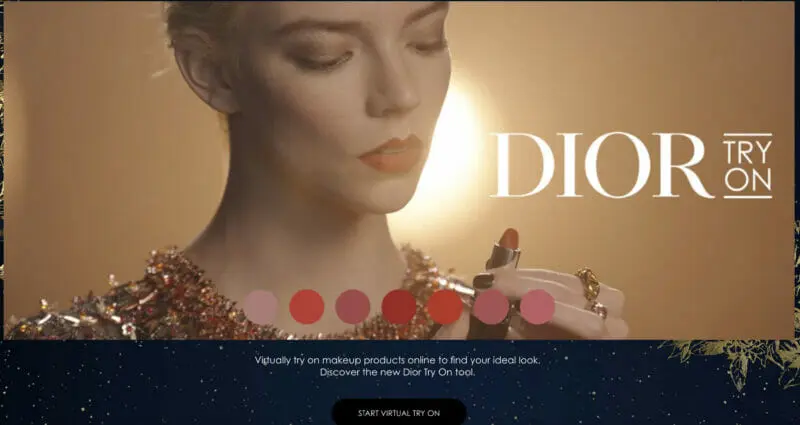
Source: dior.com
Similarly, you can experiment with these latest tools to apply immersion into your own customer touchpoints. For example, at the awareness stage, you could introduce an AR filter that allows users to customize one of your products. This would allow them to explore the endless potential for customization and might entice them to consider your products. That’s what Tod’s did with their My Di Bag Instagram filter, which allows users to create customized Di bags virtually.
5. Analyze and Improve
Just like any other initiative, it’s not easy to get immersive experiences right the first time around. Perhaps your AR filter isn’t working correctly or maybe people don’t really know how to use it, for example. In some cases, it’s even possible that people don’t find a use for the immersive experience you’re introducing.
This makes it crucial to analyze the impact of your initiative and even collect customer feedback when relevant. Look at usage data and customer behavior to see just how much adoption the experience is seeing. You could also provide a short feedback form at the end of every purchase to see what customers have to say about the immersive experience you introduced.
This will help you understand what you’re doing wrong and what improvements you need to make. Applying customer feedback and analytics data can help you develop immersive experiences that engage the customers and provide value.
Gearing Up for Immersive Experiences
Immersive customer experiences are a great way to engage your audience and win loyal customers. However, it takes strategic planning to get it right. Use the steps given above to guide your immersion initiative.
Frequently Asked Questions
How do you create immersive customer experiences?
You can create immersive customer experiences by leveraging technology such as VR, AR, and mixed reality.
How do you immerse customers?
You can immerse customers by creating experiences that allow them to interact with your brand through multiple senses.
What are immersive techniques?
Immersive techniques merge simulated or digital reality with the physical world using technologies such as AR and VR.
Why is immersive experience important?
Immersive experiences can enhance the overall customer experience, drive purchase decisions, improve conversions, and reduce return rates.
What does customer immersion mean?
Customer immersion is the process of immersing customers in the brand experience using mixed reality technology across various touchpoints.

